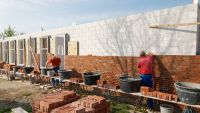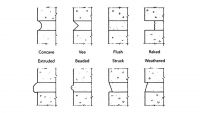Flashing Case-by-Case
A look at three flashing systems and how they work
By Masonry
Flashing is of paramount importance to modern masonry walls. Today's masonry wall must accommodate moisture penetration by providing a collection and drainage system. Flashing also helps prevent water penetration at interfaces with other building systems, such as windows and other penetrations. Through the following series of case studies, Masonry looks at three flashing systems and how they have worked in specific situations.
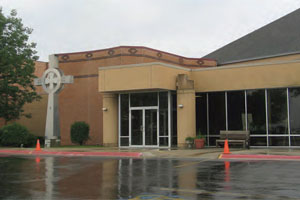
Divine Invention
ChallengeThe nearly 50-year-old St. Patrick's Church School in North Kansas City, Mo., was to undergo upgrading and remodeling of its brick exterior. To guard against future water damage or mold growth, the church needed a reliable moisture-control system installed in the remodeled walls. However, the budget was tight.
Approach
North Kansas City-based MTS Contracting specified the restoration version of TOTALFlash, made by Mortar Net USA, as the moisture-control system.
Two key reasons were cited:
- Although the all-in-one product itself was a bit more expensive than conventional flashing, it offered more protections. Each five-foot panel of flexible flashing included a built-in termination bar, built-in mortar-capture system, built-in weep tabs, built-in edge dam, built-in drip-edge, and foolproof lap joints. Since all components were pre-assembled onto the flashing panels, all materials would arrive together, with no downtime waiting for deliveries.
- Regarding the tight budget, TOTALFlash's speed of installation would not only offset cost, but also it would create substantial net savings in time and labor. MTS won the bid, and the installation went beautifully.
Result
MTS had a profitable job, and the church received much better protection for its brick walls than could normally have been afforded.
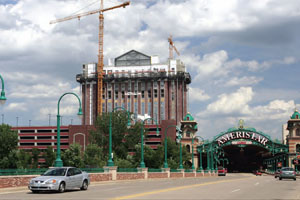
Ameristar Casino/Hotel
St. Charles, Mo., is the place where the Lewis & Clark Expedition started its trek in 1804, and it served as the first capitol of the new state of Missouri from 1821 to 1826. But being right on the river has its problems. In 1993, due to continuous heavy rains, the Missouri River was above flood stage for 94 days at St. Charles, leading to tremendous damage throughout the region.One area of concern in high-rise building is meeting strict seismic codes. As recently as 1968, an earthquake centered in southern Illinois with a magnitude 5.5 shock caused damage in St. Charles and nearby St. Louis. The potential for earthquakes and the sometimes unpredictable weather along the river make St. Charles and the St. Louis area in general a challenging place for builders.
When the Ameristar Casino in St. Charles planned to expand with an upscale, 400-room hotel, the lead architect, PGAV in Kansas City, Mo., added an exterior wall consultant, Heitmann and Associates from St. Louis, to the team to assure the plans would prevent future problems.
Geoff Hart, project director for Heitkamp Masonry, the MCAA member company in Ellisville, Mo., that did the work, recalls the project. "It was a massive masonry job: a 26-story high-rise with a large footprint, almost 300 X 100 feet, utilizing approximately 600,000 utility-size bricks and approximately 75,000 square feet of glass fiber reinforced concrete.
"Due to seismic requirements that the building had to be able to move one inch in each direction, at every building corner we couldn't use brick or pre-cast because it was too heavy," Hart says. "We had to use glass-fiber reinforced concrete, which had an expansion joint on either side of the building corner. This was two foot each direction by nine-foot-four tall, and at the ends of each two foot section, you had a 3/4-inch expansion joint and a two-inch expansion joint running the height of the building."
At every vertical nine-foot, four-inch point, there is a relief angle that needs to be flashed. The flashing called out was Hohmann & Barnard's Flex Flash, a 40-mil, self-adhering membrane.
"In each case, at the top there was a stainless-steel termination bar that was attached to the structure of the building with screws and then caulked," he says. "Then the flashing ran down on top of the relief angles, so the relief angle had to be primed and sealed with a bead of caulk. A three-inch-deep piece of stainless-steel drip edge was installed on the horizontal portion of the angle with caulk. The Flex-Flash flashing was then installed on top of the drip edge and sealed with a bead of caulk. So, there was extensive use of a Dow Corning caulk on this project as well."
Heitkamp had crews dedicated to putting down flashing. "The flashing had to be there before we could put the brick down," says Hart. "We had two crews of three bricklayers, and all they did was install flashing ahead of us. Then, after the flashing was down, we videotaped both the installation and the finished product before we laid a brick down."
Hart suggests other contractors faced with similar expanded requirements follow some precautions. "First, be sure you fully understand the installation methods required by the architect, consultants and owners. Second, document very carefully the installation procedures, so if the building should get water in it, you are assured that you're work, or lack of work, was not the cause of any leaking in the building.
"Third, insist on pre-testing the system," he continues. "That was something we insisted on, and the engineer really liked the suggestion that this flashing system get thoroughly tested, both for water penetration and what might happen in the event of a seismic occurrence. With the pretest, you're assured that, if the system passes, it will perform in the event of a catastrophic seismic event or any massive rain."
Finally, get the material vendor to help. Hohmann and Barnard provided on-site help for Hart's crews. "We had them come out twice to review our installation methods and critique them to ensure we were doing it per the manufacturer's suggested methods," he says. "They, in turn, wrote a formal report to the general contractor and the owner saying that we were above and beyond compliance."
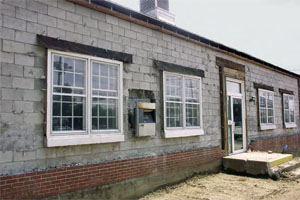
The Many Lives of Copper Flashings
New products constantly flood the construction industry. Some promise and deliver real positive advantages, while others leave questions as to their real advantages over possible new disadvantages. Moisture management has been a real concern in all phases of construction for centuries. It is generally agreed that moisture must be dealt with in a way that will protect a structure for life. Properly designed through-wall flashings are the widely accepted answer to moisture migration in typical cavity wall construction. Proper attention should be given to the location of these flashings, along with the type of materials used.For hundreds of years, copper has been used in those critical areas where moisture management is a concern. It could be said that copper flashings have stood the test of time and continue to be the most reliable flashing product to assure lasting protection. When choosing a flashing material, longevity should be your main objective.
Case and Point
About 50 years ago, a small U.S. Post Office was built in Hampton, N.H. The structure was a basic brick exterior with a block interior wall. This structure served as a post office for about 22 years and then was sold to a local bank. Due to the location of the building and local zoning regulations, the size and general appearance of the building could not be altered. Thus, the new owners could make only minor changes to the exterior of the structure. Windows and doors were replaced in favor of new, more energy-efficient models, but the approximate size and location remained unchanged.
Twenty-eight years later, the bank relocated, and the building was sold to a national donut chain. Once again, minor changes were undertaken to change the doors and windows, but the location remained the same, as did the structure — and the flashing. The flashing over the windows and door is the original copper fabric flashing that was installed about 50 years prior (see image). The longevity of copper has proven itself through the many lives of this small structure in New Hampshire, and will continue to protect against moisture problems through the years and changes ahead.
Conclusion
This story is not unique. Walk down the streets of a large city, such as Boston or New York, and you'll see extensive use of copper in most of the oldest structures in the city. Will peel-and-stick and PVC flashings be around 50 years from now? New products constantly flood the construction market. Choose wisely.
About the Author
Masonry, the official publication of the Mason Contractors Association of America, covers every aspect of the mason contractor profession - equipment and techniques, building codes and standards, business planning, promoting your business, legal issues and more. Read or subscribe to Masonry magazine at www.masonrymagazine.com.













